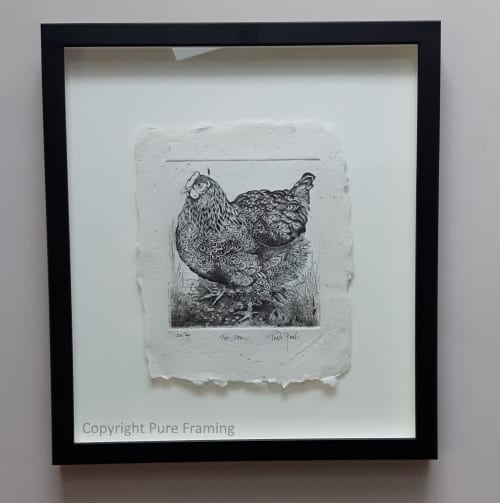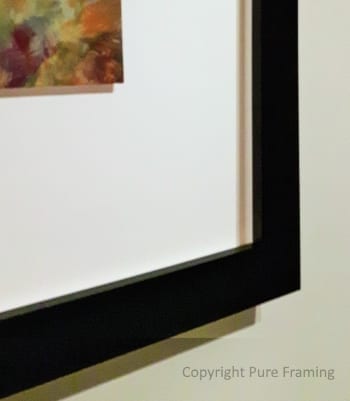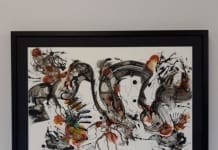 Float mounting can be a great way to present an artwork in a frame, particularly if you want the outside edge to be visible. Examples where this could be important include artwork on handmade paper with a deckled edge (see the first photograph), or perhaps a picture that is not entirely square and this is part of its charm, or the detail comes right to the edge and you don’t want to lose any of it.
Float mounting can be a great way to present an artwork in a frame, particularly if you want the outside edge to be visible. Examples where this could be important include artwork on handmade paper with a deckled edge (see the first photograph), or perhaps a picture that is not entirely square and this is part of its charm, or the detail comes right to the edge and you don’t want to lose any of it.
For float mounting, a mount is still used behind the artwork to form a border around it. The artwork can be attached directly to the mount so that it is flush with the surface, or it can be raised above the mount slightly. This second method is known as “shadow float mounting”. With a shadow float mount, a spacer is placed between the back of the item and the mount board to create a little distance (and a shadow). The spacer is not visible as it is cut slightly smaller than the artwork. Shadow float mounting can add dramatic effect and elevate a fairly ordinary picture into something quite special. Take a look at the photo of the small acrylic painting on board – it was about 10cm x 10cm, but by the time it had been shadow float mounted and given a wide border around it, it looked very striking and quite substantial.
 When having any artwork framed (and by artwork I mean anything you want framed – photographs, original art, prints, textiles, objects), you always need to consider its value (financial, historical or sentimental) and whether there is any chance in the future that either you or someone else may want to re-frame it, or remove it from its frame and mount.
When having any artwork framed (and by artwork I mean anything you want framed – photographs, original art, prints, textiles, objects), you always need to consider its value (financial, historical or sentimental) and whether there is any chance in the future that either you or someone else may want to re-frame it, or remove it from its frame and mount.
There are of course a number of different ways of attaching an artwork to the mount when float mounting, and you will find that different framers have their favourite methods and materials for doing this. Check what method the framer is planning to use, as some methods and materials are permanent making it difficult (if not impossible) to remove in the future. The methods I prefer to use are reversible, and involve using gummed tapes which can be safely removed from the back of the artwork in the future if required.
When glazing a float mounted artwork, also ensure that the framer spaces the glazing away from the framed item. Glazing which touches the artwork may cause damage to its surface over time (see previous “Frame & Fortune” for details of this).
If you need any advice or want some framing done for you, please feel free to contact me – my details can be found on my website www.pureframing.co.uk
Help keep news FREE for our readers
Supporting your local community newspaper/online news outlet is crucial now more than ever. If you believe in independent journalism, then consider making a valuable contribution by making a one-time or monthly donation. We operate in rural areas where providing unbiased news can be challenging. Read More About Supporting The West Wales Chronicle






















